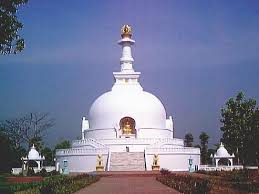
Vaishali was one of the Buddha's favourite resorts and he visited it on several occasions It was here that he had his famous encounter with the prostitute Ambapali, the incident is recounted in the Mahaparinibbana Sutta in The Long Discourses. Another discourse he delivered here is the long but interesting Mahasihanada Sutta from The Middle Length Discourses. According to the Mahayana tradition the famous Vimalakirtinedesa Sutra was preached here too.
About a hundred years after the Buddha's Parinirvana the city was the venue for the Second Council where hundreds of monks from all over northern India met together to sell settle a dispute about Vinaya rules and to chant the suttas together. The main things to see today are the famous lion pillar, the museum, the large Kharauna Lake, the Japanese temple and the stupa built over the Vijjians' one eighth share of the Buddha's ashes.
Location
Vaishali is situated in the eastern Indian state of Bihar, around 55 km off Patna, the capital of the state. Vaishali extends from latitude 25° in the North to longitude 85° in the East. The town, an important place for both the Buddhists and Jains, is well connected to other important cities in Bihar by road.
History
Believed to be the first republic in the world, Vaishali has taken its name from King Vishal of the Mahabharat age. He is said to have constructed a great fort here, which is now in ruins. Vaishali is a great Buddhist pilgrimage and also the birthplace of Lord Mahavira. It is said that the Buddha visited this place thrice and spent quite a long time here. The Buddha also delivered his last sermon at Vaishali and announced his Nirvana here. After his death, Vaishali also held the second Buddhist Council.
The great Lichchavi clan ruled Vaishali in the sixth century BC, and the empire extended up to the hills of Nepal. The Lichchavi state is considered to be the first republican state of Asia. According to the Jataka stories, (Buddhist story books giving the account of different births of the Buddha), Vaishali was ruled by some 7707 kings of the Lichchavi clan. Ajatshatru, the great Magadh King, annexed Vaishali in the fifth century BC and after that Vaishali gradually lost its glory and power.